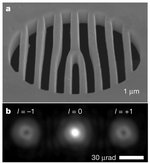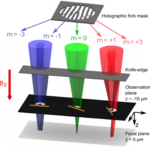Phase Manipulation in Electron Microscopy
Electron beams have been used for analyzing materials for a long time – e.g. in transmission electron microscopes. For most purposes, their rotation does not play an important role. From a classical point of view, an electron current in vacuum does not carry any orbital angular momentum. However, quantum mechanically, the electrons have to be pictured as a wavelike current that can rotate around its direction of propagation, similar to the air current in a tornado.
Vortex beams made of light have been in use in optics for some time now (e.g. as optical tweezers for manipulating small particles). In much the same way, electron vortex beams offer numerous possibilities to control nanoparticles and to measure properties related to angular momentum.
The generation of electron vortex beams was made possible using a lattice-like mask cut out of a Platinum foil. Just as in optics, an electron beam sent through such a mask gets diffracted. The shape of the mask, that is only a few micrometer in diameter, was calculated in such a way that an incident plane electron wave is converted into electron vortex beams. Behind the mask, a left-handed and a right-handed vortex beam is formed, while in the center, a conventional electron beam without rotation can be found.
When sending electrons through a material that influences the electrons’ angular momentum and subsequently sending the emerging electron beam through the tailored Platinum mask, one finds that in the end either the left-handed or the right-handed electron vortex beam is more intense than the other. That opens the possibility to study angular momentum-related processes in nanomaterials much more accurately than before.
Requests: Thomas Schachinger



